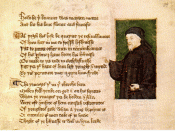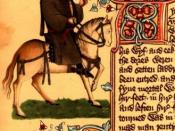In the Middle Ages, love was believed to be a certifiable disease from which one cannot escape. Written throughout medieval literature, this sickness was said to ruin bonds or friendships between ÃÂbrothersÃÂ, lead towards sin, and diminish the health of men. A womanÃÂs point of view was never accounted for, because she was the temptress and she was the cause of this love sickness. ÃÂMedieval courtly love is often a one-way affair: it is seen from the point of view of the man, whose feelings are of great interest and may be analyzed at length, while the woman exists only as an object arousing those feelingsÃÂ (Spearing 11). In the KnightÃÂs Tale two cousins swear loyalty to each other as brothers and break this bond when Emily gives them no choice but to become sick with unquenched love over her beauty.
EmilyÃÂs love-invoking beauty was personified as a May garden, which was the main symbol for beauty in medieval courtly poetry.
ÃÂTill it fil ones, in a morwe of May, That Emelye, that fairer was to sene Than is the lilie upon his stalke grene, And fresher than the May with floures newe ÃÂ For with the rose colour stroof hire hewe, I noot which was the finer of hem twoÃÂ (Chaucer 176-81). Chaucer uses this imagery often whenever he was describing ArciteÃÂs and/or PalamonÃÂs love for her. Yet, ÃÂArcite and Palamon have no choice but to behave the way they do; they must love Emily, whatever extravagance or absurdity their love may lead them into, because they are suffering from a sicknessÃÂ (Spearing 10). This sickness seems to instantly break the brotherly bond between the two knights. Since Palamon saw her and fell in love with her first, Arcite should have respected his love and helped him get...


